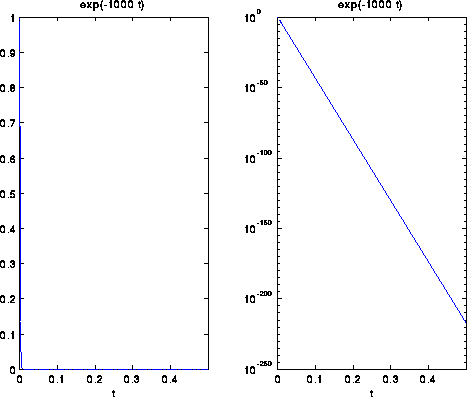

Let h>0 be the stepsize, and t(i)=i*h. If we apply Euler's method with stepsize h>0, then we approximate the differential equation by the simpler equation (a straight line):
x( t+h ) ~ x( t ) - h*1000*x( t ) = (1-h*1000) * x(t)
We use this approximation to compute an approximate solution
x(i) ~ x( t(i) ) by the analogous formula
x( i+1 ) = x( i ) - h*1000*x( i )
= (1-h*1000) * x( i )
= (1-h*1000)^i * x( 1 ) .
For the computed solution x(i) to approach 0 monotonically as does the
exact solution x(t(i)), we need to choose h so that 0 < 1-h*1000 < 1, or
0 < h < 1/1000. In other words, we must take very short steps,
even after x(t) is very small. For if we don't, for instance if h = .01 and so
1-h*1000 = -9, then the solution will grow in magnitude by a factor of 9
and oscillate from step to step, rather than decay to zero.
In contrast, suppose we apply Backward Euler with stepsize h. We get the approximation (a different straight line):
x( t+h ) ~ x( t ) - h*1000*x( t+h )
or
(1 + h*1000) * x( t+h ) ~ x( t )
or
x( t )
x( t+h ) ~ ----------
1 + h*1000
yielding the formula
x( i ) x( 1 )
x( i+1 ) = ---------- = ----------------
1 + h*1000 ( 1 + h*1000 )^i
For the computed solution x(i) to approach 0 monotonically,
we need to choose h so
that 1+h*1000 > 1; this is true for all positive values of h, so we
can take large step sizes, and find the solution x( t ) for large t
in many fewer steps than Euler.
The accuracy with which the computed solution x(i) approximates the true solution x( t(i) still depends on h -- the smaller h is the more accurate the approximation -- but this is a topic for a class in numerical analysis of ordinary differential equations, like Math 228a.